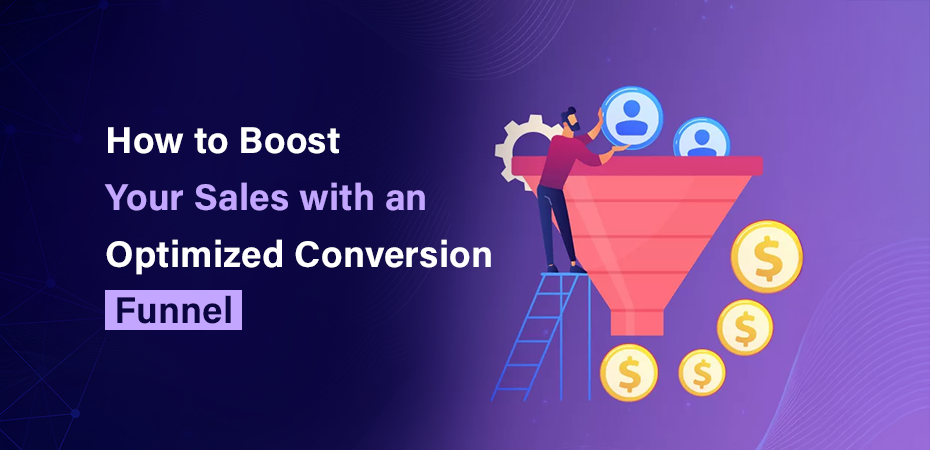How to Boost Your Sales with an Optimized Conversion Funnel



Your business is like a finely tuned machine, guiding potential customers from their first encounter with your brand to the exciting moment they click “buy now.” This process is known as the conversion funnel – a strategic pathway that transforms curious visitors into loyal customers.
Think of your conversion funnel as a digital sales assistant, working around the clock to guide potential buyers through their purchasing journey. It starts by grabbing their attention, piquing their interest, and ultimately leading them to make a purchase. Just like in-person sales, each stage requires careful attention and the right approach.
But here’s the catch – simply having a conversion funnel isn’t enough. The real magic happens when you optimize each stage to perfection. A well-optimized funnel can significantly increase your sales by:
- Reducing customer drop-offs
- Increasing engagement rates
- Shortening the sales cycle
- Maximizing revenue potential
Are you ready to transform your marketing strategy into a powerful sales tool? Let’s explore the world of funnel optimization and learn how to convert more prospects into satisfied customers.
Conversion Funnel- Definition and Stages
Definition of a Funnel of Conversion
A conversion funnel means a strategic framework that outlines the step-by-step journey a customer takes from their first interaction with your brand to completing a desired action, such as making a purchase. It helps businesses understand how potential customers move through different stages—awareness, interest, consideration, and decision—while identifying opportunities to optimize engagement and reduce drop-offs.
By analyzing customer behavior at each stage, businesses can refine their marketing efforts, personalize interactions, and streamline the user experience to increase conversions. An effective conversion funnel not only attracts prospects but also nurtures them with relevant content, trust-building strategies, and seamless navigation, ultimately guiding them toward a successful purchase.
Stages of a conversion funnel:
Let’s break down each stage of the funnel to understand how customers move through your sales pipeline:
1. Awareness Stage
Your potential customers discover your brand through social media, blog posts, or ads. They’re just starting to realize they have a problem that needs solving.
2. Interest Stage
Prospects begin exploring your solutions. They might subscribe to your newsletter, download resources, or follow your social media accounts to learn more.
3. Consideration Stage
At this point, leads actively evaluate your offerings. They compare prices, read reviews, and assess whether your product meets their needs.
4. Intent Stage
Customers show clear buying signals. They might add items to their cart, start a free trial, or request a demo.
5. Purchase Stage
The final step where prospects become customers by completing their purchase.
Each stage requires specific marketing strategies to guide customers forward:
- Awareness: Educational content and brand-building campaigns
- Interest: Engaging social media content and lead magnets
- Consideration: Product comparisons and case studies
- Intent: Special offers and personalized recommendations
- Purchase: Clear checkout process and purchase incentives
Understanding these stages helps you create targeted content and marketing messages that resonate with customers at each point in their journey. This strategic approach increases your chances of converting prospects into loyal customers.
1. Attracting Attention in the Awareness Stage
The awareness stage marks your first chance to capture potential customers’ attention. Let’s explore proven conversion strategies to make your brand stand out in a crowded marketplace.
Content Marketing Magic
Creating valuable content helps you connect with your target audience naturally. Blog posts, infographics, and educational videos position your brand as an industry expert while addressing your audience’s pain points. A software company might share how-to guides about productivity, while a fitness brand could create workout videos.
Social Media Advertising
Strategic social media marketing campaigns put your brand directly in front of interested audiences. Platforms like Facebook and Instagram offer precise targeting options based on demographics, interests, and behaviors.
A local restaurant might target food enthusiasts within a 5-mile radius, while an online course creator could focus on professionals seeking career advancement.
Analytics Tools for Success
Track your awareness campaigns with tools like:
- Google Analytics – Monitor website traffic and user behavior
- Social media insights – Track engagement and reach
- Heat mapping tools – Understand how visitors interact with your content
- UTM parameters – Measure the effectiveness of specific campaigns conversions
Pro tip: Test different content formats and advertising approaches to discover what resonates best with your audience. A mix of organic content and paid advertising often yields the best results.
Remember to adjust your awareness strategies based on analytics data. Your target audience’s preferences and behaviors will guide your approach to creating impactful campaigns that generate quality leads.
2. Nurturing Interest and Consideration with Engaging Content
Once you’ve captured your audience’s attention, it’s time to deepen their interest and guide them through the consideration phase. This stage requires strategic content creation that speaks directly to your prospects’ needs and concerns.
Creating Value-Driven Content
Your content should answer key questions and solve specific problems your potential customers face. Try these proven formats:
- Detailed how-to guides that showcase your expertise
- Video tutorials demonstrating product features
- Case studies highlighting real success stories
- Educational webinars addressing industry challenges
- Comparison guides helping prospects make informed decisions
Building Trust Through Social Proof
People trust other people’s experiences. Here’s how to leverage social proof effectively:
- Display customer testimonials prominently on your website
- Share authentic user-generated content on social media
- Highlight industry awards and certifications
- Feature detailed customer reviews with photos
- Showcase real-time statistics of your customer base
Personalization Matters
Tailor your content based on:
- Previous interactions with your brand
- Industry-specific pain points
- Company size and budget
- Geographic location
- Stage in the buying process
Remember to track engagement metrics for each piece of content. This data helps refine your approach and create more targeted materials that resonate with your audience. A/B testing different content formats and messaging styles can reveal what works best for your specific market segment.
3. Driving Action through Persuasive CTAs and Seamless Checkout Experiences
Your potential customers have shown interest in your product. Now it’s time to transform that interest into action. Let’s explore proven strategies to guide them through the intent and purchase stages.
Create Urgency with Time-Sensitive CTAs
- “Limited time offer – Save 30% today only”
- “Only 5 spots remaining at this price”
- “Flash sale ends in 2 hours”
These time-bound CTAs tap into the fear of missing out (FOMO) and prompt quick decisions. Remember to display countdown timers or limited stock indicators to reinforce the urgency.
Simplify Your Checkout Process
A complicated checkout process can drive customers away. Here’s how to keep it smooth:
- Implement a guest checkout option
- Display a progress indicator
- Limit form fields to essential information
- Save customer details for future purchases
- Offer multiple payment options
Reduce Cart Abandonment
Cart abandonment often happens due to unexpected costs. Try these fixes:
- Show shipping costs early in the process
- Display security badges prominently
- Send automated cart recovery emails
- Provide live chat support during checkout
- Offer price matching guarantees
Test and Optimize
Run A/B tests on your Call To Actions (CTA) and checkout process. Test different button colors, text variations, and page layouts. Track metrics like click-through rates and abandonment rates to identify areas for improvement.
4. Fostering Loyalty and Advocacy for Long-Term Success
The real magic happens after a customer makes their first purchase. A well-crafted post-purchase strategy transforms one-time buyers into lifelong brand champions.
Personalized Follow-up Campaigns
- Send thank-you emails with product usage tips
- Create custom product recommendations based on purchase history
- Share exclusive “customer-only” content
- Offer early access to new products or features
Loyalty Programs That Work
A points-based rewards system can drive repeat purchases. Here’s what makes loyalty programs stick:
- Easy-to-understand earning structure
- Valuable, achievable rewards
- Multiple ways to earn points
- Mobile app integration for convenient tracking
Turn Customers into Brand Advocates
Happy customers love sharing their experiences. Give them the tools to spread the word:
- Create shareable unboxing experiences
- Design Instagram-worthy packaging
- Offer referral bonuses for both parties
- Build an exclusive community for your brand champions
Engagement Beyond the Sale
Keep the conversation going with:
- Birthday rewards and anniversary perks
- Interactive social media challenges
- User-generated content campaigns
- VIP customer events and previews
Remember to measure customer satisfaction through regular surveys and feedback loops. Use this data to refine your loyalty tactics and create even more meaningful customer experiences for your brand community.
Leveraging Technology for Funnel Optimization
The right technology stack can transform your market conversion optimization funnel strategy from good to exceptional. Let’s explore powerful tools that can supercharge your optimization efforts.
Analytics and Tracking Tools
- Google Analytics helps track user behavior, traffic sources, and conversion paths
- Mixpanel offers detailed user journey analysis and cohort tracking
- Segment centralizes customer data for better decision-making
A/B Testing Platforms
- Optimizely enables testing different versions of your website
- VWO helps experiment with various elements to find winning combinations
- Google Optimize offers free testing capabilities for smaller businesses
Heatmapping and User Behavior Tools
- Hotjar visualizes user interactions through heatmaps and session recordings
- Crazy Egg tracks click patterns and scroll depth
- MouseFlow captures user frustration signals and form analytics
CRM and Marketing Automation
- HubSpot streamlines lead nurturing and customer relationship management
- Mailchimp automates email campaigns based on user behavior
- Salesforce provides comprehensive customer journey tracking
Conversion Rate Optimization (CRO) Tools
- Unbounce helps create and test landing pages
- Lucky Orange identifies user friction points
- Leadfeeder tracks website visitors and their behavior
These tools provide valuable insights into user behavior, helping you identify bottlenecks and optimization opportunities. The key lies in selecting tools that align with your business goals and integration needs. Start with basic funnel analytics tools and gradually expand your tech stack as you understand your specific optimization requirements.
Remember to regularly review and update your tool selection based on performance metrics and changing business needs. A data-driven approach to conversion funnel analysis and optimization leads to increased conversion rates and improved ROI.
Conclusion
A well-optimized conversion funnel marketing is essential for the growth of your business. It allows you to connect with potential customers at each stage and guide them towards making a purchase. To achieve this, it’s important to understand your audience’s needs, create targeted content, and use data-driven insights to improve your approach.
Your conversion funnel in business requires ongoing attention and improvement. This is because market trends change, customer preferences evolve, and new technologies emerge. By regularly monitoring and optimizing your funnel, you can identify any obstacles in the customer journey, adjust to changing consumer behaviors, get the most out of your marketing investments, build stronger relationships with your customers, and achieve sustainable revenue growth.
The tools and strategies discussed in this guide will help you optimize your conversion funnel. However, it’s important to remember that successful optimization takes time, testing, and a commitment to continuous improvement.
Want to enhance your market conversion funnel? Check out our extensive resources at Phoenix SEO Ninja for advanced conversion optimization strategies and expert insights to boost your sales potential.
Frequently Asked Questions (FAQs)
Results vary based on your industry and current funnel performance. You might see initial improvements within 2-4 weeks, but significant results typically emerge after 3-6 months of consistent optimization.
Each stage plays a vital role. The effectiveness of your funnel depends on how well all stages work together to guide prospects toward conversion.
Yes! Businesses of any size can implement funnel optimization strategies. Start small, focus on one stage at a time, and scale your efforts as you see positive results.
Track your key metrics weekly, but conduct thorough analyses monthly. This schedule helps you spot trends while allowing enough time for meaningful data collection.